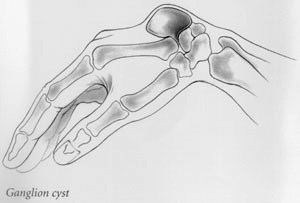Finding a lump on your hand or wrist can be a frightening experience. But most of the time, these are harmless ganglion cysts, or wrist cyst, that will often disappear in time.
Commonly, ganglion cysts grow on the top of the wrist (dorsal ganglions). But they can also be found on the underside of the wrist (between the thumb and your pulse point), at the end joint of a finger or at the base of a finger.
A ganglion grows out of a joint, like a balloon on a stalk that rises out of the connective tissues between bones and muscles. Inside the balloon is a thick, slippery fluid similar to the fluid in your joints. Usually, the more active you are, the larger the lump becomes; when you rest, the lump decreases in size.
What causes Ganglion Cysts?
No one knows what triggers the formation of a ganglion. Women are more likely to be affected than men, and ganglions are common among gymnasts, who repeatedly apply stress to the wrist. Because the fluid-filled sac puts pressure on the nerves that pass through the joint, some ganglion cysts may be painful.
Large ganglions, even if they are not painful, are unattractive. Smaller ganglions that remain hidden under the skin (occult ganglions) may be quite painful.
Examination and Diagnosis
Your doctor may ask you how long you’ve had the ganglion, whether it changes in size and if it is painful. He or she may apply pressure to see if there is any tenderness, or hold a penlight up to the cyst to see if the light shines through.
You will probably need to get an X-ray, so that the doctor can rule out conditions such as arthritis or a bone tumor. Sometimes, an MRI or ultrasound is needed to find a ganglion cyst hidden under the skin.
Wrist Cyst Treatment Options
The first course of treatment is nonsurgical and conservative.
- Observation. Because the ganglion is not cancerous and may disappear in time, the physician may recommend just waiting and watching to make sure that no radical changes occur.
- Immobilization. Activity often causes the ganglion to increase in size, thus increasing the pressure on nerves and causing pain. Your physician may recommend that you wear a wrist brace or splint to relieve symptoms and allow the ganglion to decrease in size. As pain decreases, your doctor may prescribe exercises to strengthen the wrist and improve range of motion.
- Aspiration. If the ganglion causes significant pain or severely limits your activities, you may choose to have the doctor drain the fluids with a procedure called “aspiration.” The doctor will numb the wrist and puncture the cyst with a needle to remove the fluid.
 These treatments leave the outer shell and the stalk of the ganglion intact, so it may reform and reappear. Outpatient surgery can remove the ganglion, but is no guarantee that the cyst will not recur. Part of the involved joint capsule or tendon sheath may also be removed.
These treatments leave the outer shell and the stalk of the ganglion intact, so it may reform and reappear. Outpatient surgery can remove the ganglion, but is no guarantee that the cyst will not recur. Part of the involved joint capsule or tendon sheath may also be removed.
This is of little concern, but afterwards you may feel some tenderness, discomfort and swelling. You should be able to resume normal activities in two to six weeks.
